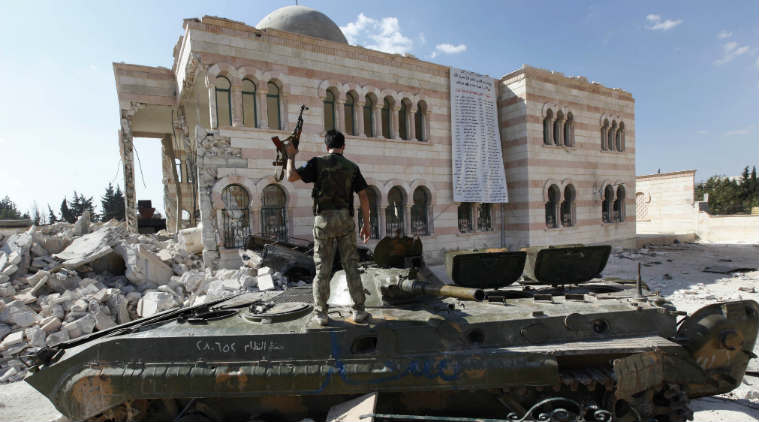Stay updated with the latest - Click here to follow us on Instagram
Timeline: Here are the key events in the Syria conflict since March 2011
A timeline of key events during the Syrian conflict from the anti-regime protests in 2011 till present.
 FILE – 21 March 2011, Syrian policemen stand in front of a court building that was set on fire by Syrian anti-government protesters, in the southern city of Daraa, Syria. (AP Photo)
FILE – 21 March 2011, Syrian policemen stand in front of a court building that was set on fire by Syrian anti-government protesters, in the southern city of Daraa, Syria. (AP Photo)
As Syrians mark the fifth anniversary of the uprising against President Bashar Assad, here are some of the key events in the conflict:
March 2011: Protests erupt in the city of Daraa over security forces’ detention of a group of boys accused of painting anti-government graffiti on the walls of their school. On March 15, a protest is held in Damascus’ Old City. On March 18, security forces open fire on a protest in Daraa, killing four people in what activists regard as the first deaths of the uprising. Demonstrations spread, as does the crackdown by Assad’s forces.
April 2011: Security forces raid a sit-in in Syria’s third-largest city, Homs, where thousands of people tried to create the mood of Cairo’s Tahrir Square, the epicenter of protests against Egypt’s autocrat Hosni Mubarak.
[related-post]
June 2011: Police and soldiers in Jisr al-Shughour in northeastern Syria join protesters they were ordered to shoot, and the uprising claims control of a town for the first time. Elite government troops, tanks and helicopters retake the town within days.
August 2011: President Barack Obama calls on Assad to resign and orders Syrian government assets frozen.
July 2012: A bombing at the Syrian national security building in Damascus during a high-level government crisis meeting kills four top officials, including Assad’s brother-in-law and the defense minister.
 FILE – 23 September 2012, a Free Syrian Army soldier stands on a damaged Syrian military tank in front of a damaged mosque, on the outskirts of Aleppo. (AP Photo)
FILE – 23 September 2012, a Free Syrian Army soldier stands on a damaged Syrian military tank in front of a damaged mosque, on the outskirts of Aleppo. (AP Photo)
Summer 2012: Fighting spreads to Aleppo, Syria’s largest city and its former commercial capital.
August 2012: Kofi Annan quits as UN-Arab League envoy after his attempts to broker a cease-fire failed. Obama says the use of chemical weapons in Syria would be a “red line” that would change his thinking about military action.
March 2013: After advancing in the north, rebel forces capture Raqqa, a city of 500,000 people on the Euphrates River and the first major population center controlled by the opposition.
May-June 2013: Backed by thousands of Lebanese Hezbollah fighters, Assad’s forces re-capture the strategic town of Qusair from rebels, near the border with Lebanon.
August-September 2013: A chemical weapons attack in the Damascus suburbs kills hundreds. Obama, blaming Assad’s government, says the US has a responsibility to respond and puts it up to a vote in Congress. Russia proposes instead that Syria give up its chemical weapons, averting military strikes.
October 2013: Syria destroys its chemical weapons production equipment. The number of Syrian refugees registered with the UN tops 2 million.
January 2014: Infighting among rebels spreads, pitting a variety of Islamic groups and moderate factions against the al-Qaida-breakaway Islamic State of Iraq and the Levant.
 FILE – June 30, 2014, fighters from the Islamic State group ride tanks during a parade in Raqqa, Syria. (Raqqa Media Center via AP)
FILE – June 30, 2014, fighters from the Islamic State group ride tanks during a parade in Raqqa, Syria. (Raqqa Media Center via AP)
February 2014: Two rounds of peace talks led by UN-Arab League mediator Lakhdar Brahimi in Geneva end without a breakthrough.
9 May: Rebels withdraw from the old quarter of the central city of Homs in a significant symbolic victory for the government.
13 May: Brahimi resigns as UN-Arab League envoy to Syria, marking a second failure by the United Nations and Arab League to end the civil war.
3 June: Syrians in government areas vote in presidential elections. Assad, one of three candidates, overwhelmingly wins with 88.7 percent.
June: The Islamic State group, as the Islamic State of Iraq and the Levant is now known, seizes large parts of northern and western Iraq. In control of around a third of Syria and Iraq, it declares a self-styled Islamic caliphate.
3 July: Islamic State group takes control of Syria’s largest oil field, al-Omar, after fierce battles with the Nusra Front, al-Qaida’s branch in Syria.
19 August: Islamic State militants release video of the beheading of American journalist James Foley, the first of five Westerners to be beheaded by the IS group.
Mid-September: IS begins offensive to take Syrian Kurdish town of Kobani, on the Turkish border.
23 September: US-led coalition begins airstrikes against Islamic State group targets in Syria.
 FILE – 10 August 2014, an aircraft lands after missions targeting the Islamic State group in Iraq from the deck of the US Navy aircraft carrier USS George H.W. Bush in the Persian Gulf. (AP Photo)
FILE – 10 August 2014, an aircraft lands after missions targeting the Islamic State group in Iraq from the deck of the US Navy aircraft carrier USS George H.W. Bush in the Persian Gulf. (AP Photo)
January 2015: UN estimates Syria’s conflict has killed at least 220,000 people and uprooted nearly a third of the prewar population of 23 million from their homes.
26 January: With the help of US-led airstrikes, Kurdish fighters take control of Kobani.
3 February: IS releases a video of captured Jordanian pilot Muath al-Kaseasbeh being burned to death in a cage.
28 March: The northwestern city of Idlib falls to Islamist groups led by the Nusra Front.
6 May: President Bashar Assad acknowledges serious setbacks for his military.
30 September: Russia begins launching airstrikes in Syria in support of Assad’s forces.
14 November: Seventeen nations meeting in Vienna adopt a timeline for a transition plan in Syria that includes a new constitution as well as UN-administered parliamentary and presidential elections within 18 months.
18 December: The UN Security Council adopts resolution 2254 endorsing the Vienna road map for a transitional period in Syria.
3 February 2016: Indirect peace talks between the Syrian government and opposition in Geneva collapse a few days after starting, over a Russian-backed Syrian army offensive in Aleppo.
22 February: The US and Russia announced a partial cease-fire in Syria will start on Feb. 27.
9 March: The UN’s Syria envoy says indirect peace talks will resume in Geneva on March 14.







- 01
- 02
- 03
- 04
- 05
























